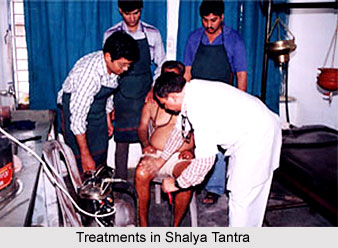 Treatments in Shalya Tantra refer to the methods of surgery in Ayurveda. In the ancient India, Ayurvedic treatment pioneered surgery. Shalya Chikitsa is a noteworthy branch of Ayurvedic science. The name of the sage-physician Sushruta is synonymous with surgery. From his thesis called Sushruta Samhita, it is known that thousand of years ago complicated methods of surgery were practiced in India. Topics of intestinal obstructions, bladder stones, and the use of dead bodies for dissection and learning were exercised and taught in ancient India.
The treatments in Shalya Tantra is clearly mentioned in the original text of Sushruta that widely discusses about an exhaustive range of surgical methods including about how to deal with various types of tumours, internal and external injuries, fracture of bones, complications during pregnancy and delivery, and obstruction in intestinal loop. Susruta was the first surgeon to expand cosmetic surgery and promote the treatments in Shalya Tantra. His surgical treatment for trichiasis is still believed to be one of the modern operative techniques used for eye diseases.
The use of various surgical instruments while the treatments in Shalya Tantra are also described in the Sushruta Samhita. The instruments described in the treatments in Shalya Tantra were made from stone, wood and other such natural materials. The treatment of Shalya Tantra was popular because this could give fast relief as compared to the time-consuming process of recovery from medicines or herbs.
Diseases that required instant treatment in those cases shalyachikitsa were considered to be the best method. Charaka the best-known physician of Ayurvedic medicine also suggested for Shalya Tantra in treatment of certain diseases that requires immediate attention like hemorrhoids. The long foreign rule in India and lack of endorsement halted the progress of Ayurvedic surgery in the middle of the second millennium. The treatments in Shalya Tantra are the branch of Ayurveda, which deals with the treatment of Agni as well.
Treatments in Shalya Tantra refer to the methods of surgery in Ayurveda. In the ancient India, Ayurvedic treatment pioneered surgery. Shalya Chikitsa is a noteworthy branch of Ayurvedic science. The name of the sage-physician Sushruta is synonymous with surgery. From his thesis called Sushruta Samhita, it is known that thousand of years ago complicated methods of surgery were practiced in India. Topics of intestinal obstructions, bladder stones, and the use of dead bodies for dissection and learning were exercised and taught in ancient India.
The treatments in Shalya Tantra is clearly mentioned in the original text of Sushruta that widely discusses about an exhaustive range of surgical methods including about how to deal with various types of tumours, internal and external injuries, fracture of bones, complications during pregnancy and delivery, and obstruction in intestinal loop. Susruta was the first surgeon to expand cosmetic surgery and promote the treatments in Shalya Tantra. His surgical treatment for trichiasis is still believed to be one of the modern operative techniques used for eye diseases.
The use of various surgical instruments while the treatments in Shalya Tantra are also described in the Sushruta Samhita. The instruments described in the treatments in Shalya Tantra were made from stone, wood and other such natural materials. The treatment of Shalya Tantra was popular because this could give fast relief as compared to the time-consuming process of recovery from medicines or herbs.
Diseases that required instant treatment in those cases shalyachikitsa were considered to be the best method. Charaka the best-known physician of Ayurvedic medicine also suggested for Shalya Tantra in treatment of certain diseases that requires immediate attention like hemorrhoids. The long foreign rule in India and lack of endorsement halted the progress of Ayurvedic surgery in the middle of the second millennium. The treatments in Shalya Tantra are the branch of Ayurveda, which deals with the treatment of Agni as well.




















